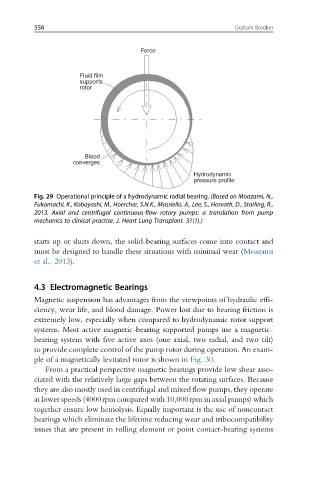Page 563 - Handbook of Biomechatronics
P. 563
556 Graham Brooker
Force
Fluid film
supports
rotor
Blood
converges
Hydrodynamic
pressure profile
Fig. 29 Operational principle of a hydrodynamic radial bearing. (Based on Moazami, N.,
Fukamachi, K., Kobayashi, M., Hoercher, S.N.K., Massiello, A., Lee, S., Horvath, D., Starling, R.,
2013. Axial and centrifugal continuous-flow rotary pumps: a translation from pump
mechanics to clinical practise. J. Heart Lung Transplant. 31(1).)
starts up or shuts down, the solid-bearing surfaces come into contact and
must be designed to handle these situations with minimal wear (Moazami
et al., 2013).
4.3 Electromagnetic Bearings
Magnetic suspension has advantages from the viewpoints of hydraulic effi-
ciency, wear life, and blood damage. Power lost due to bearing friction is
extremely low, especially when compared to hydrodynamic rotor support
systems. Most active magnetic-bearing supported pumps use a magnetic-
bearing system with five active axes (one axial, two radial, and two tilt)
to provide complete control of the pump rotor during operation. An exam-
ple of a magnetically levitated rotor is shown in Fig. 30.
From a practical perspective magnetic bearings provide low shear asso-
ciated with the relatively large gaps between the rotating surfaces. Because
they are also mostly used in centrifugal and mixed flow pumps, they operate
at lower speeds (4000rpm compared with 10,000rpm in axial pumps) which
together ensure low hemolysis. Equally important is the use of noncontact
bearings which eliminate the lifetime reducing wear and tribocompatibility
issues that are present in rolling element or point contact-bearing systems

